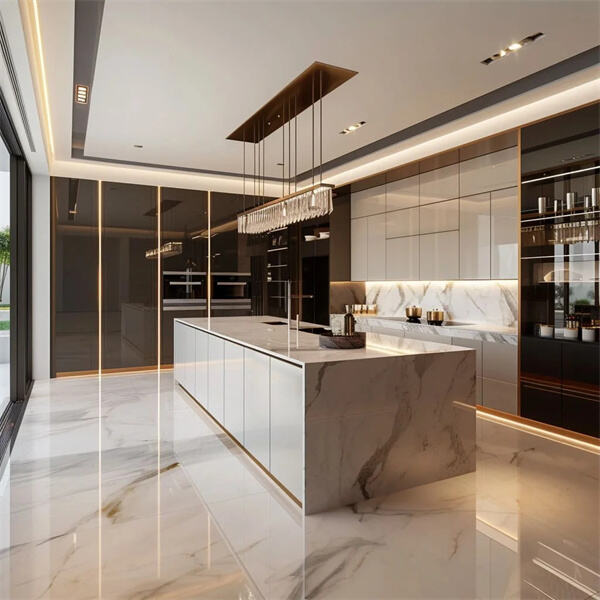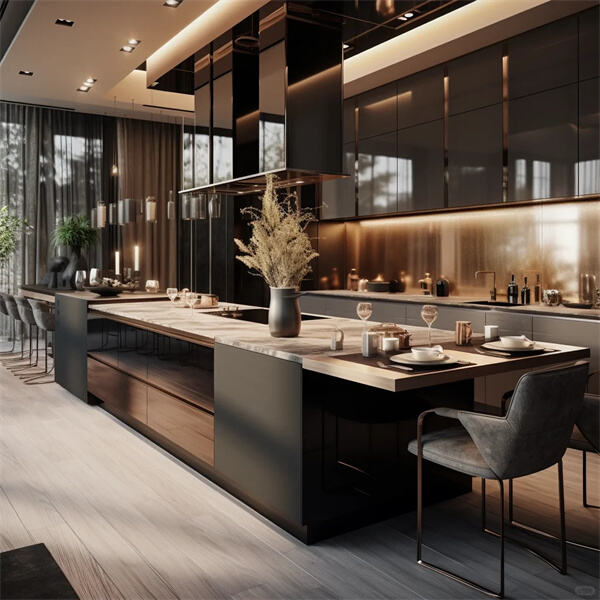איך ניתן להתאים Schränke מטבח לפי תכנונים ייחודיים של מטבחים?
למטבח כל יש אופי משלו, שצורתו על ידי תכונות ארכיטקטוניות, הגבלות מרחב והעדפות הבעלים. ממטבחים צרickers בצורת מנהרה ועד מרחבים פתוחים עם תקרות נוטות, תכנונים ייחודיים דורשים לרוב יותר מ Schränke סטנדרטיים ומזומנים.
התאמת Schränke המטבח לפי דרישה מאפשרת לבעלים לנצל את המקסימום את הפונקציונליות, להעצים את המראה ולנצל בצורה מיטבית גם את המרחבים הקשים ביותר. בואו נחקור את האסטרטגיות, החומרים והשיטות העיצוביות שהופכות Schränke מטבח מותאמים אישית לפתרון האידיאלי לתכנונים ייחודיים של מטבחים.
עיצוב מודולרי ובוקס פלוני: גמישות לכל צורה
מודולרי ארונות מטבח שינינו את אופי ההתקנה, ומציעים פתרון אמצעי בין התקנות מותאמות אישית לחלוטין לבין התקנות סטנדרטיות. מערכות אלו מורכבות מחלקים מוגדרים מראש (ארונות בסיס, ארון קיר, מגררות) שניתן לשלב ביניהם ולהתאים כדי להתאים מרחבים בלתי סטנדרטיים. לדוגמה, במטבח עם תקרה נוטה—שנפוץ במרחבים המרהטים או בדירות עתיקות—ניתן לחתוך ארון הקיר המודולריים לגבהים שונים, לעקוב אחרי קווית הגג כדי למנוע בזבוז של מרחב. רגליים מתאימות בתחתית הארון הבסיסיות מאפשרות יישור על רצפות לא שטוחות, בעיה נפוצה בדירות היסטוריות.
למגורים עם עיצוב ייחודי—כגון מטבחים עם קירות מעוגלים, פינות בעייתיות או נישות מובנות—ארונות מטבח במתכונת מותאמת (מותאם אישית לחלוטין) הם הפתרון. אומנים מוכשרים יכולים לעצב ארונות שמכסים קשתות ומשטחים מעוגלים, ויצירת מראה חלקי, או לבנות יחידות פינה עם מדפים סיבוביים (סלי סוזן) כדי לאפס את אזורי ה„מתים“. במטבח עם עמוד מרכזי, ניתן לבנות ארונות מותאמים סביב המבנה, ולהפוך מכשול לתכונת עיצוב—לדוגמה, על ידי הוספת מדף יינות מובנה או מדף תבלינים לצד העמוד.
גם האפשרויות המודולריות וגם הייחודיות ממקדות גמישות. בעלי בתים יכולים לבחור משרד עומקים (מ-12 אינץ' לקירות nôngים ועד 24 אינץ' לאזורים נרחבים) וגובהים (ארונות גבוהים לארון מזון אנכי, או ארונות נמוכים מתחת לחלונות) כדי להתאים את המגורים. גמישות זו מבטיחה שהאינץ' האחרון במטבח יושם ביעילות, בין אם מדובר בפער צר בין מכשירים ובין אם באלקובה שקועה.
התאמה אישית של חומרים ומסגרות: התמזגות עם הארכיטקטורה
מותאם אישית ארונות מטבח אינן קשורות רק לגודל – חומרים ומסגרות ממלאים תפקיד חשוב בהכללתם במבנים ייחודיים ובסגנונות אדריכליים. לדוגמה, במטבח רוסטי עם קירות לבנים חשופים, ארונות עשויים מעץ משומש עם מסגרת מזוקנת מתאימים את המרחב, בעוד שארונות אקריליים חלקים וברקניים מגבילים את המטבח המודרני עם קווים זוויתיים.
בחירת החומרים משפיעה גם על תפקוד בפרטים ייחודיים. במטבחים קטנים, חומרים קלים כמו HDF (לוח סיבים בצפיפות בינונית) עם גימור למינטני מפחיתים את המשקל, מהMakes that makes את התקנת הארון הקדמי לקיר חלש יותר פשוטה. במטבחים עם לחות גבוהה (למשל, ליד תנור או באקלים טרופי), חומרים עמידים בפני לחות כמו פליז מarine-grade או ארונות PVC מונעים עיוות.
ניתן להתאים גימורי פנים כדי להסתיר או להדגיש תכונות של סדרת המטבח. ארון עם גימור אפלה יכולים לספק אפקט של 'כיווץ' במטבח גדול ובלתי סדיר, וגורמים לו להרגיש ביתי יותר, בעוד ארון בגוון בהיר (לבן, שמנת, או גווני פסטל) פותחים ומרחיבים מטבח קטן וחנוק. ארון עם דלתות זכוכית, כאשר הם ממוקמים בקיר בודד במטבח צר וארוך, מוסיפים עומק מבלי לכבוש את הסדרה, ומייצרים אשליה של מרחב.

פתרונות אחסון: מותאמים לרגלי המשתמש
סדרות מטבח ייחודיות דורשות לעיתים פתרונות יצירתיים לאחסון, וארונות מטבח מותאמים יכולים להיבנות בהתאם לשימוש של בעלי הבית במרחב. לדוגמה, מטבח עם מעט משטח עבודה ייהנה מארונות עם תכונות מובנות כמו משטח חיתוך שנסדק החוצה, מדף לבשמים, או מפרידים אנכיים לתבניות אפייה. תוספות אלו הופכות משרד עומק ללאחסון פונקציונלי.
במטבחים פתוחים המשמשים גם כמרחב מגורים, ניתן לכלול בארונות פתרונות אחסון מוסתרים כדי לשמור על מראה נקי. לדוגמה, משרד דלת מקופלת יכולה להסתיר סט של מצלמה ביתית קטנה, בעוד יחידת אשפה וסילוק יוצאת החוצה שומרת על סלי האשפה מחוץ לעין. במטבחים המשמשים ילדים, ארונות תחתונים עם תיוקים הנעולים בעדינות ופינות מעוגלות מונעים תאונות, בעוד מדפים מתכווננים גדלים יחד עם הצרכים של המשפחה (למשל, מדפים גבוהים יותר עבור כלים של מבשלים בוגרים כשהילדים גדלים).
מטבחים פינתיים, שהיו תמיד אתגר לארונות סטנדרטיים, floreieren עם התאמה אישית. אפשרויות כמו ארונות פינה אלכסוניים (עם דלתות שנפתחות בזווית של 45 מעלות) או ארונות פינה יוצאים ('פינות קסם', שמורידות פריטים אל הקדמה) הופכות את המרחב הזה לנגיש. לדוגמה, משפחה שאוהבת לאפות יכולה להזמין ארון פינה שנועד לאחסון קערות ערבוב ו תבניות אפייה, עם גישה נוחה דרך מדף יוצא.
שילוב עם מקלחות: חלקה ופונקציונלית
מתקנים ייחודיים למטבחים מחייבים לעיתים קרובות שהأجهزة יותקנו במיקומים לא סטנדרטיים - מתחת לחלונות, ליד פתחים, או בפינות מותאמות. Schränke מותאמים למטבח מבטיחים שהأجهزة יתמזגו עם הארון, ויצרו מראה אחיד תוך שמירה על פונקציונליות.
לדוגמה, מטבח עם חלון מעל המרתף (פריסה נפוצה בדירות ישנות) יכול להכיל ארונות קדמית מותאמים אישית שמכסות את החלון, עם חריצים שמתאימים לצורת המסגרת. בדרך זו נמנעים מרווחים לא נוחים שנוצרים כאשר משתמשים בארונות סטנדרטיים, שלרוב הם גבוהים מדי מכדי להתאים מתחת לחלונות. במטבח עם חתך קטן, ארון צר (עמוק 30–38 ס"מ) יכול להכיל מקרר צר או תנור מיקרוגל, תוך מקסום השימוש במרחב מבלי להתפשר על איחסון.
מתקנים מובנים הם תחום נוסף שבו התאמה אישית מצוינה. ניתן לתכנן ארון מותאם כדי להקיף מנועית או לגרום לכך שתיראה חלק מהריהוט, או להתאים תנור כפול בגובה המתאים לבעלים (לדוגמה, נמוך יותר לצורך נגישות). במטבחים עם תנור עצמאי, גב טופס מותאם וארונות צד יכולים לכסות את הפער בין המתקן לקיר, למנוע הצטברות אבק וליצור מראה מטופח.
שאלות נפוצות: התאמת ריהוט מטבח לשרשורים ייחודיים
כמה עולה להתאים ריהוט מטבח לשרשור ייחודי?
המחירים משתנים בהתאם: ארונות מותאמים במבנה מודולרי עולים בין 300 לאורך רגל ליניארי, בעוד אפשרויות ייחודיות לגמרי עשויות לעלות 500– 1,500 לאורך רגל ליניארי. גורמים כמו חומרים (עץ מוצק מול צדפות), מורכבות (ארונות עגולים, איחסון מותאם), ועבודה 손אית משפיעים על המחיר. התאמה קטנה ופשוטה (לדוגמה, התאמת גובה הארון לתקרה נוטה) עשוייה להעלות ב-10–20% את עלות הארון הסטנדרטית.
כמה זמן לוקח לעצב ולתקנן ארונות מטבח מותאמים אישית?
ארונות מודולריים מותאמים אישית נוטים להימשך 4–6 שבועות (שבועיים לעיצוב, 2–4 שבועות לייצור והתקנה). ארונות בסיוט (Bespoke) יכולים להימשך 8–12 שבועות, שכן הם מצריכים מדידות מדויקות, אומנות ומספר גרסאות עיצוב. תכנונים מורכבים (למשל, קירות עגולים, אילוצים בمنازלים היסטוריים) עשויים להוסיף 2–4 שבועות.
האם ניתן לעדכן את הארונות המותאמים אישית במועד מאוחר יותר אם התכנון משתנה?
מערכות מודולריות מציעות גמישות רבה יותר – ניתן לארגן מחדש או להחליף יחידות בודדות אם התכנון משתנה (למשל, הוספת אי מטבח במועד מאוחר יותר). ארונות בסיוט (Bespoke), שנבנו כך שיתאימו בדיוק למבנה מסוים, קשים יותר להמרה, אך לעיתים ניתן לשנות אותם (למשל, חיתוך ארונית אם מוסרים קיר). מומלץ להתייעץ עם המעצב על נושא ההתאמה לעתיד.
האם יש הגבלות על מה שניתן להשיג בארונות מטבח מותאמים אישית?
למרות גמישות רבה, קיימים אילוצים מסוימים: קירות נושאים לא ניתן לשנות כדי להתאים לארונות, וחללים קטנים במיוחד (לדוגמה, מתחת ל-50 רגל מרובע) עלולים להגביל אפשרויות אחסון. בנוסף, חומרים כמו עץ מוצק עלולים להתקוות בסביבות לחות, ולכן נדרשת גימור מיוחד. מעצב מוכשר יעבוד בתוך הגבולות הללו כדי למצוא פתרונות.
איך אני מוודא שהארונות המותאמים אישית במטבח מתאימים למיקום הייחודי שלי בצורה מדויקת?
שכרו מעצב או ארוןאי עם ניסיון בעיצוב מיקומים ייחודיים – הם ישתמשו בתוכנת מודלים תלת-ממדיים כדי ליצור עיצובים מדויקים לפני הייצור. מדידות באתר (שנערכת לאחר שיפוצים, כמו הסרת קירות) הן קריטיות, שכן אפילו הבדלים קטנים (אינץ' עד שניים) יכולים להשפיע על ההתאמה. בקשו מהמעצב מודל בקנה מידה או סיבוב וירטואלי כדי לדמיין את התוצאה הסופית.
תוכן העניינים
- איך ניתן להתאים Schränke מטבח לפי תכנונים ייחודיים של מטבחים?
-
שאלות נפוצות: התאמת ריהוט מטבח לשרשורים ייחודיים
- כמה עולה להתאים ריהוט מטבח לשרשור ייחודי?
- כמה זמן לוקח לעצב ולתקנן ארונות מטבח מותאמים אישית?
- האם ניתן לעדכן את הארונות המותאמים אישית במועד מאוחר יותר אם התכנון משתנה?
- האם יש הגבלות על מה שניתן להשיג בארונות מטבח מותאמים אישית?
- איך אני מוודא שהארונות המותאמים אישית במטבח מתאימים למיקום הייחודי שלי בצורה מדויקת?

